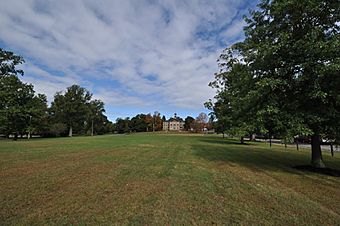Woodstock Hill Historic District facts for kids
Quick facts for kids |
|
|
Woodstock Hill Historic District
|
|

View up the village green to the academy
|
|
| Location | Roughly along Plaine Hill Rd., and Academy Rd., including parts of Old Hall Rd. and Child Hill Rd., Woodstock, Connecticut |
|---|---|
| Area | 100 acres (40 ha) |
| Architect | Wells, Joseph Collins; Alexander S. Cutler, et al. |
| Architectural style | Colonial, Federal, Greek Revival |
| NRHP reference No. | 98001578 |
| Added to NRHP | January 6, 1999 |
The Woodstock Hill Historic District is a special area in Woodstock, Connecticut. It's like a time capsule showing how the village looked long ago. This district includes many old and important buildings. It's centered around the Woodstock Green, a grassy area in the middle of town.
This historic district stretches south from the Woodstock Green. It goes towards where Connecticut Route 169 meets Plaine Hill Road. The district was added to the National Register of Historic Places in 1999. This means it's recognized as an important historical site in the United States.
Contents
What Makes Woodstock Hill Special?
The Woodstock Hill Historic District is home to several amazing buildings. These structures show different styles of architecture from the past. They help tell the story of the town's history.
Important Buildings to See
Some of the most famous buildings in the district include:
- The Congregational Church: This church was built in 1821. It's a beautiful example of early American architecture.
- Woodstock Academy: This school has several buildings within the district. Its main classroom building, built in 1873, stands proudly overlooking the Woodstock Green.
- Roseland Cottage: This house is a National Historic Landmark. It's known as one of the best examples of Gothic Revival summer houses in the country. It has a unique and fancy style.
These buildings are important because they show how people lived and built things many years ago.
A Look Back at Woodstock's History
Woodstock has a long and interesting history. It was first settled by English colonists in 1686. These settlers came from a place called Roxbury in the Massachusetts Bay Colony.
Early Days of Woodstock
When it was first settled, Woodstock was known as New Roxbury. This name lasted until 1690, when it officially became Woodstock. The first settlers chose to live along a ridge where Plain Ridge Road is today. They also set aside the area for the town green, the church, and a cemetery right from the start.
The current Congregational Church is actually the third church on that spot. The very first church was finished in 1691.
Henry Chandler Bowen's Impact
A very important person in Woodstock's history was Henry Chandler Bowen. He was a descendant of one of the town's first settlers. Henry Bowen became a very successful businessman in New York City.
He spent his summers at Roseland Cottage in Woodstock. He was also very generous to the village in the late 1800s. This kind of generosity is called philanthropy. Bowen helped fund the 1873 building for Woodstock Academy. He also sponsored big Fourth of July celebrations, making the town a lively place. His contributions helped shape the Woodstock we see today.



